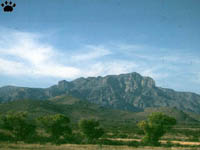
Bolson de Mapimi, Chihuahua Desert, Mexico.
Deserts - Part 2
The best place to look for wildlife in the desert is around
trees and other large plants.
In this puia (middle picture), I found nests of 5
bird species, including a flicker's hole on top. Hummingbirds and doves nested
between leaves, finches in another flicker's hole, and tinamus at the base of
the trunk.

Nest of Le Conte's thrasher (Toxostoma lecontei, marked by
an arrow) in cholla (Cylindropuntia) cactus, Devil's Punchbowl, California.
|
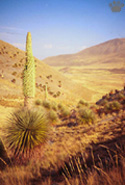
Giant Puia (Puia raimondii),
Huascaran, Peru |
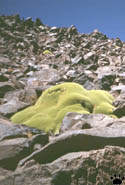
Giant Pillow (Pycnophillum),
Lagunas Coloradas, Bolivia |
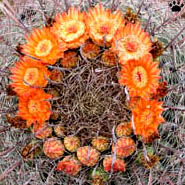 |
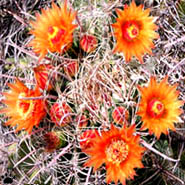 |
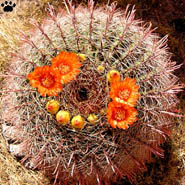 |
| Barrel cacti (Ferocactus) are common in subtropical deserts of North America. This is fishhook cactus (F.
wislizeni) from New Mexico. |
 |
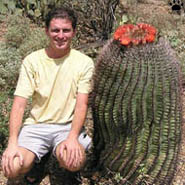 |
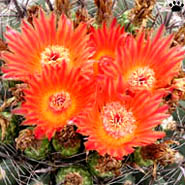 |
| Barrel
cacti of Northern Mexico, left to right: F. herreriae, F. gracilis,F.
emoryi. |
| A cactus can help you a lot in finding wildlife, but
first you have to find the cactus itself. This one (left) was growing so high
in the mountains that it had to hide underground almost completely to escape from
cold and wind. |
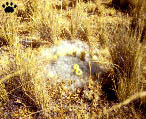
Altilobivia sp., Lagunas
Coloradas, Bolivia |
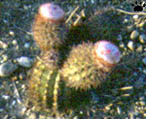
Andocereus sp.,
Trelew, Argentina |
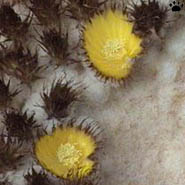 |
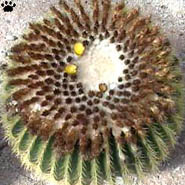 |
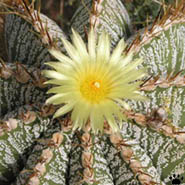 |
| Barrel cacti of Central
Mexico, left to right: F. auratus, Astrophytum ornatum. |

Borzicactus sp.,
Colca Canyon, Peru. |

Jumping Cholla (C.
fulgida), Arizona, USA. |
If you'll not find any animals around the cactus, don't be upset.
These plants are interesting enough by themselves, like this furry creatures from
High Andes (left) or the infamous, but beautiful, "jumping cholla" from
Sonora Desert (right). |
 |
 |
 |
 |
| Blooming of various
cacti, Arizona. |
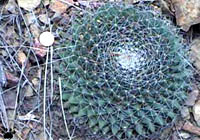
False cream cactus (Mamillaria pseudoheydei) |
Particularly weird small cacti often
grow on limestone soils. These two are from Black Gap Wildlife Management Area
in Big Bend area of Western Texas. |
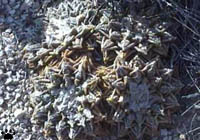
Living rock cactus (Ariocarpus fissuratus). |
 |
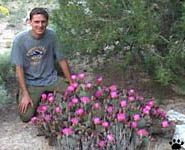 |
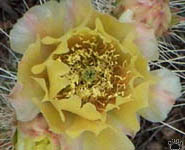 |
| Opuntia cacti of New
Mexico, left to right: O. basilaris, O. engelmanni. |

Saguaro (Cereus giganteus),
Sonora Desert, Arizona. |
In some deserts of Arizona, Mexico, Galapagos
and Argentina, beautiful forests of giant cacti and other succulents still exist.
The small patches of saguaro forest around Tucson, Arizona, are the ones most
often visited and photographed. They get even better as you move south towards
the Mexican border. Forests of Joshua tree (Yucca
brevifolia) in Mojave Desert of Alta California,
and of Boojum Tree (Fouquieria columnaris) in Baja California
are also very spectacular. |
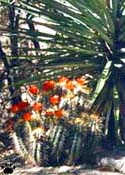
O. fulgida & Y. elata,
Sonora Desert, Arizona. |
| One of the most beautiful cacti of the world is rare
and difficult-to-find "queen of night" (Peniocereus greggii)
of Sonora Desert. Most of the year it looks like a dead twig, and blooms only
for one night. |
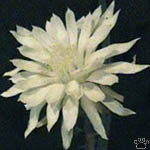
Queen of night, Yaqui River, Sonora. |
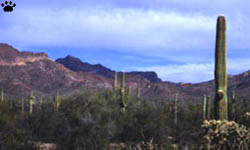
Saguaro forest in Organ Pipe Cactus National Park, Arizona. |
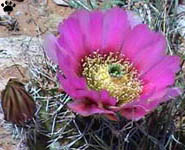 |
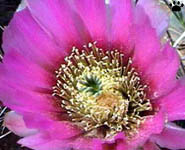 |
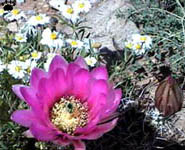 |
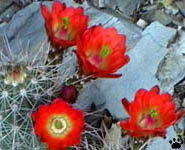 |
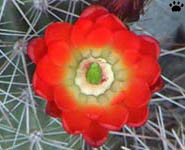 |
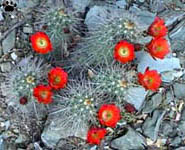 |
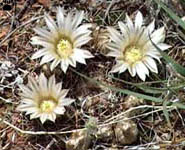 |
Cacti of Chihuahua Desert: upper
row - strawberry hedgehog (Echinocactus enneacanthus), second row - claret
cup (E. triglochidiatus), third row - cream cactus (Mamillaria macdougalii),
fourth row - Chihuahua pineapple cactus (Echinomastus intertextus) and
cotton cactus (M. lenta) ; bottom row: ruby pincushion cactus (M. rubinus),
southern beehive cactus (Coryphantha bumamma), and little beauty (C.
macromeris). |
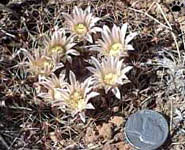 |
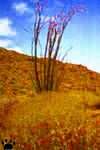
Blooming ocotillo,
California. |
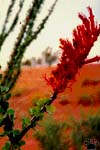
Ocotillo flower,
California. |
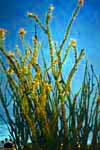
Ocotillo after rain,
Arizona. |
Ocotillo (Fouquieria splendens) is the only member of
a large Mexican genus in the United States. It usually looks like a bunch of dry
sticks, but shortly after rains it becomes covered with red flowers (in spring),
or tiny, bright-green leaves (in summer). |
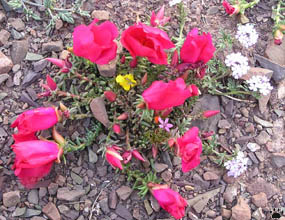 |
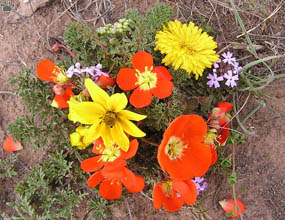 |
| Puna flowers, Los Cardones National
Park, Argentina. |
| In South African deserts, cacti are replaced by bizzare-looking
Euphorbiaceae and Aizoaceae, including "living stones"
(Lithops) - indoor gardeners' favorites. |

Lithops hookeri. |

L. geyeri. |

L. lesliae. |

Assorted Lithops. |
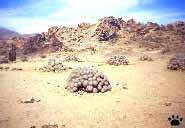
Spherocactus infernalis, Pan de Azucar, Chile |
In some areas, cacti are the only plants. In this
part of Coastal Desert in Chile, for example, rains fall only in years of strong
El Ninyo or after major earthquakes, which mix up layers of warm and cold water
in the ocean. Cacti get water from great depth, where it is flowing slowly from
Andes to the ocean many miles away. Certain parts of South American deserts are
the driest places on Earth. On Nazca Plateau,
rains fall once in few centuries, and the air is so dry that human bodies left
in the open never disintegrate. In other places, there probably have never been
raining since the last Ice Age. |
| But even in these deserts there is life. Night mists
from nearby ocean bring moisture to western slopes of coastal hills. In late winter,
strange vegetation appears on bare sand - lomas meadows. Plants of lomas
have no roots or use them only to avoid being blown away. They get all water they
need from mists, and all fertilizing from dust. Some of them roll into tiny balls
every morning to avoid water loss, but spread hairy leaves at night to catch as
much dew as possible. Fog deserts of South America and South Africa, particularly
Namib, are not only the most bizarre, but also, according to some theories, the
most ancient deserts in the World - no wonder local plants and animals have so
many interesting adaptations to their unusual climate. |
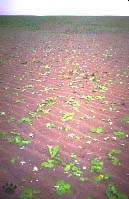
Loma de Lachay, coast of Peru |
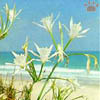
Pancratium maritimum,
Gaza, Israel. |
Much less known are fog deserts of
other continents. They exist in Western Australia, Baja California,
Northwestern Africa, Cabo Verde Islands and along the southeastern coast of the
Mediterranean Sea. The latter is the smallest of all fog deserts, only 200 miles
(320 km) long and 1-10 miles (1,6-16 km) wide, but it also has some endemic plants
and animals. |
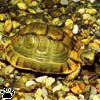
Testudo kleinmanni,
Alexandria, Egypt. |
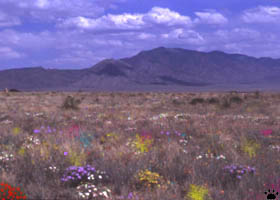 |
 |
| Spring blooming of Chihuahua Desert, Sevilleta National Wildlife Refuge, New Mexico. |
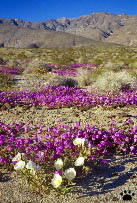
Blooming desert,
Anza Borrego, California. |
Deserts of North America normally
have rains every year, still real flower displays are rare and usually happen
in El Ninyo years. The blooming of 1998 was really outstanding - what a good luck
it was for me to immigrate to California just few
months before! From April to July, I traveled across the continent, following
the blooming. It started in Death Valley in late
February, spread to sandy washes in March, covered all plains in April, climbed
to the foothills in April and to the mountains in May, and was still beautiful
on mountain tops in July. | 
Blooming desert,
El Pinacate, Sonora. |
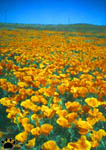 |
 |
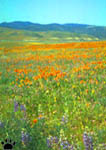 |
| Blooming California poppy
(Eschholtzia californica) and other flowers, Mojave Desert, California. |
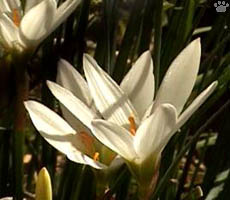
Sand lily (Leucocrinum montanum), New Mexico. |
In Sonora and Chihuahua deserts, rains
often fall twice a year: first in early spring, then in late summer. So there
are two desert blooms, with different species composition. |
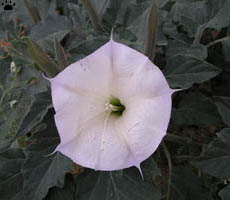
Western thorn apple (Datura wrightii),
New Mexico. |
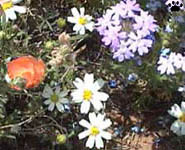 |
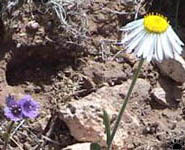 |
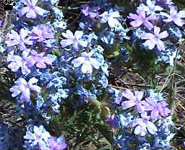 |
| Spring flowers, Sevilleta
National Wildlife Refuge, New Mexico. |
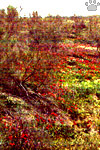
Repetek Reserve,
Turkmenistan | World's most beautiful flower displays
can be seen in early May in Turkmenistan. Here, rains fall mostly in March-April,
just in time for spring vegetation. Kopetdag Mountains and black saxaul (Haloxylon
ammodendron) forests of Repetek Nature Reserve are the best places. The blooming
starts with tulips in late March, reaches its peak in early May, when poppy species
are at their best, and ends in early June. In the mountains the flowering belt
keeps climbing to higher elevations until August. |

Repetek Reserve,
Turkmenistan |
 |
 |
 |
 |
 |
 |
| Onions of Central Asia,
left to right: Alium aflatunense, Tien Shan, A. oreophilum, Pamir,
A. azureum, Jungar, A. moly, introduced, A. sphaerocephalon,
Kashgaria, A. christophii, Turkmenistan. |
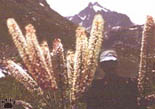
Giant foxtail lilies (Eremurus
robustus), Gissar Range,Tajikistan. |
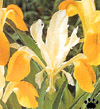
Iris bucharica,
Termez, Uzbekistan. |
Flora of Central Asia is extremely diverse, with thousands
of endemics. Some of the most beautiful flowers can only be seen in remote locations,
such as tzar bells (Ostrovskia), foxtail lilies, rare orchids, giant onions
with football-size flowers, and dozens of tulip species. |
 |
 |
 |
 |
 |
 |
 |
 |
Tulips of Turkmenistan,
upper row, left to right: Tulipa fosteriana, T. chrysantha, T. pulchella, T.
bakeri, T. sylvestris, T. palinifolia; lower row, left to right:T. tarda,
T. batalinii (yellow and red varieties), T. clusiana. |
 |
 |
| Tulipa greigi is the world's largest and most beautiful
tulip. It can be seen, together with many other tulips, in the dry foothills of
Tian-Shan Mountains in late March. One of the best sites is Kurdai Pass on Kyrgyzstan/Kazakhstan
border, near Bishkek. |
 |
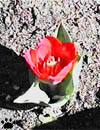 |
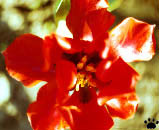 |
| Ochris aksuensis, Tulipa
wilsoniana and T. greigi, Kyrgyzstan. |
|

T. greigi,
Kurdai Pass,
Kyrgyzstan |

T. darwini,
Kurdai Pass,
Kyrgyzstan |

T. rex,
Ata,
Kyrgyzstan |

T. pamirensis,
Khorog,
Tajikistan |

T. iris
Chimgan,
Uzbekistan |

T. kaufmanni,
Atytau,
Kazakhstan |

T. praestans,
Ala-Archa,
Kyrgyzstan |

Spring flowers, Aidere, Turkmenistan |
Unlike in the North American deserts, spring blooming
occurs almost annually here. Many desert creatures, from mites to wild sheep,
visit deserts at this time, and spend the rest of the year underground, in the
high mountains, or further north. From July to March, deserts of Central Asia
are much less interesting, except in Mongolia, where
rains mostly fall in summer months. |

Acris locust,
Aidere. |
| Of all desert plants, parasites are the most bizarre.
These foot-tall plants grow in spring on saxaul roots. They have no leaves, and
their flowers are pollinated by hawk moths. They are rare, as are many species
of rapidly disappearing saxaul forests. Repetek Nature Reserve is probably the
last place where these beautiful forests are not threatened. |

Cistanche flava,
Repetek, Turkmenistan. |
 |
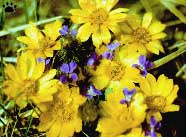
Forget-me-nots (Myosotis tatarica) and adonis
(Adonis uralensis), Alan, Chechen Republic |
Dry grasslands and sage deserts of Kazakhstan, Ciscaucasia
and Southern Siberia also have spring displays, but, unfortunately, most areas
with rich vegetation have been destroyed by agriculture. Temperate grasslands
can now only be seen in small Nature reserves or in Mongolia. |
| Dry foothill steppes of Ciscaucasia were once covered
by the World's largest and most beautiful poppy, Papaver bracteatum, with
flowers up to 25 cm (10') in diameter. Now this species is practically extinct
in the wild: its range had been converted into pastures and fields, and the last
plants were collected for bouquets or for thebain, a narcotic drug they contained.
The area where this photo had been taken in 1989 was later turned into army camp. |

Thebain poppy (P. bracteatum),
Kabardinsk, Russia. |
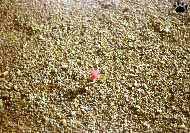
Unknown species, Changtang, Tibet |
In high deserts of Pamir
and Tibet, there are lots of beautiful flowers, too, but there are no "displays"
- plants just use every day of warm season. Only in Changtang,
the highest and driest part of Tibet, there is so little moisture that flowers
do not bloom every year. If monsoon clouds manage
to break in this isolated basins, they let flowers appear in usually barren plains.
But in narrow gorges of northern Karakoram there is not enough rain anyway, and
plants grow only along rivers. |

Endangered Georgian Iris (Iris
georgica), Hosrov, Armenia |
Large stemless irises
are the most showy flowers of dry basins of Kurdistan and Transcaucasia.
Some are endemic to vernal pools around Mt. Ararat.
|
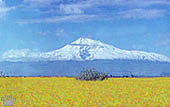
Vernal vegetation near
Mt.Ararat, Armenia |
| Deserts of Israel are also known for beautiful irises,
but most of these flowers are very local, have short blooming period and can be
difficult to find. |
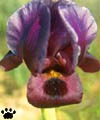
Iris hieruchamensis,
Negev Desert, Israel. |
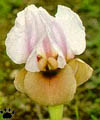
Iris lortelli,
Judean Desert, Israel. |
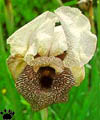
Iris bismarkiana,
Jordan River, Israel. |
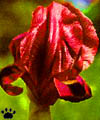
Iris atropurpurea,
Hebron, Israel. |
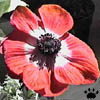
Poppy P. orientalis,
Petra, Jordan. |
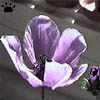
Poppy P. somniferum,
Hatussas, Turkey. |
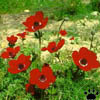
Anemone coronaria,
Khar Tavor, Israel. |
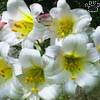
Lilium candida,
Ashkelon, Israel. |
Other famous flowers from the desert edges and dry
grasslands of the Middle East include various poppies, anemones and lilies. |
| Deserts and foothills of Asia are the homeland of
many beautiful flowers and tasty fruits. Peaches, apricots,melons, and pomegranates
from bazaars of Turkmenia and Uzbekistan are still much better than anything available
in the most expensive food stores in the West. |

Khorasan lily
(Lilium parsiana),
Atrek, Iran. |

Wild rose (Rosa
persica), Karakala,
Turkmenistan. |
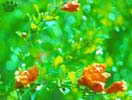
Flowers of pomegranate
(Punica granatum),
Kyzyl-Arvat, Turkmenistan. |
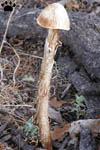
B. laciniata, Sonora. |
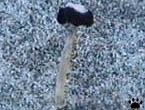
Battarea phalloides, Baja California. | 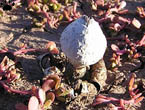
Geastrum striatum, New Mexico. |
Surprisingly, deserts also have a lot of interesting mushrooms. Here are three
unusually-looking North American species. |
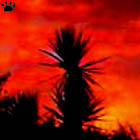
Yucca schidigera, California.
Part 3
Back to Part 1
Home
|
